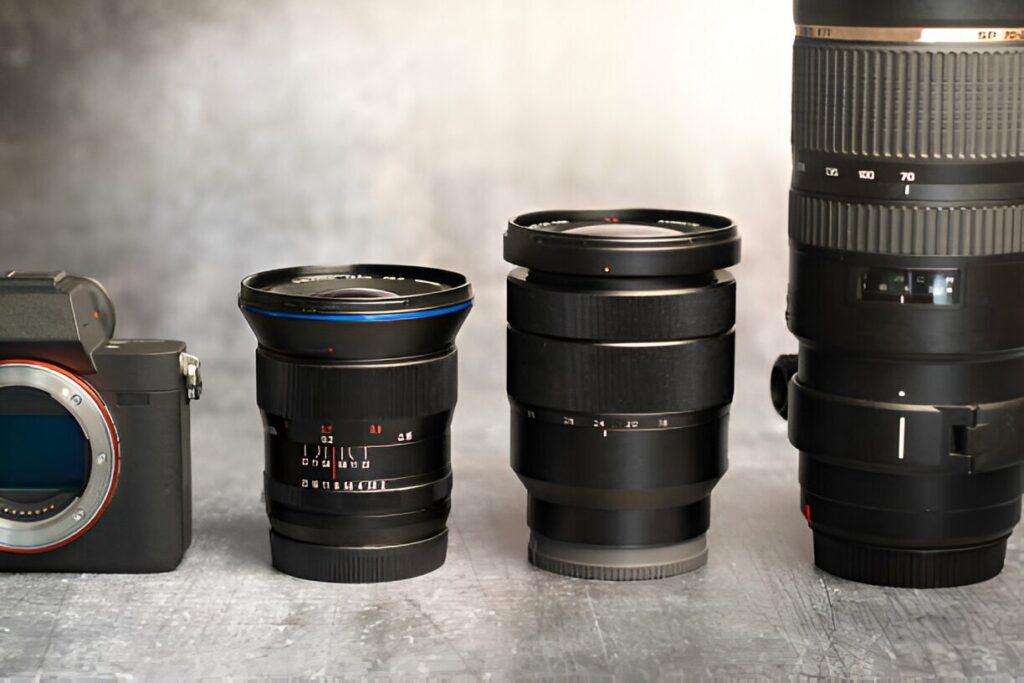Home > The Power of Perspective: Wide-Angle DSLR Camera Lenses in Landscape Photography

In the field of landscape photography, it takes both art and science to convey the vastness and beauty of the natural world. A wide-angle DSLR camera lens is an essential tool in a photographer’s toolbox for completing such an assignment. These lenses provide a distinctive viewpoint that enables photographers to capture wide-open spaces and highlight depth in their scenic shots. In this blog, we will examine the possibilities, methods, and creative potential of wide-angle lenses as we explore the power of perspective they offer to landscape photography.

Wide-angle lenses are a fundamental tool in a landscape photographer’s kit, offering unique capabilities that set them apart from other types of lenses. To truly maximize their benefits, it is essential to have a deeper understanding of how these lenses work and what makes them different.
First and foremost, wide-angle lenses have a shorter focal length compared to standard or telephoto lenses. This shorter focal length allows them to capture a wider field of view, which is crucial for landscape photography, where capturing expansive views is often the goal. For example, a wide-angle lens with a focal length of 14mm on a full-frame camera can capture a much wider scene than a standard lens with a focal length of 50mm.
One of the key characteristics of wide-angle lenses is their ability to exaggerate perspective and create a sense of depth in the image. This is achieved by the way the lens bends light as it enters the camera, resulting in a wider angle of view and greater apparent distance between foreground and background elements. As a result, objects closer to the camera appear larger, while those further away appear smaller, creating a sense of scale and dimensionality in the image.

The capacity to capture expansive perspective in photography is the most evident benefit of utilizing a wide-angle lens for landscape photography. Wide-angle lenses are excellent in fitting enormous views into the frame, whether they be of a vast desert, sweeping mountain range, or open plain. Wide-angle lenses often provide a breathtaking impression of scale and vastness by enabling the photographer to capture more of the surrounding landscape.
Furthermore, a landscape’s sense of scale can be beautifully captured using wide-angle lenses. For example, using a wide-angle lens to capture a mountain range can highlight the soaring peaks against the vastness of the sky and the surrounding landscape. In order to portray the majestic majesty of natural landscapes and inspire awe in viewers, a feeling of scale is crucial.
Emphasizing depth in a photograph is a noteworthy benefit of wide-angle lenses. These lenses provide an illusion of depth by enlarging the space between foreground and background objects, drawing the spectator into the frame. The purpose of landscape photography is to capture the immensity and three-dimensionality of the surrounding landscape, and this effect is especially helpful in this regard.
This is made possible by the wider field of vision that wide-angle lenses provide, which makes it possible to include foreground items that give the composition context and size. Photographers can produce a sense of visual depth that stretches from the front of the image to the far side of the frame by carefully positioning these front components within the frame. This photograph’s feeling of depth gives it dimensions and entices visitors to investigate the area and take in its beauty.
Adding a captivating front feature to anchor the composition and create visual interest is one of the fundamental methods in landscape photography. For this kind of photography, wide-angle lenses work great because they let you capture the huge background with foreground components included. A photograph can be made more immersive by including objects such as a rocky outcrop, a gnarled tree, or a field of wildflowers. These elements can give the image depth and context.
Foreground components also act as leading lines, directing the viewer’s attention from the front of the frame to the far side of the picture. Through the use of this method, the photograph’s visual appeal and narrative impact are enhanced by a sense of movement and flow. Photographers can improve the compositions of their shots and produce photographs that have a stronger impact on viewers by carefully choosing and positioning foreground components.
Additionally, wide-angle lenses provide photographers the chance to play around with unique compositions and viewpoints. Photographers can produce dramatic and dynamic photographs that draw in viewers by coming up close to their subject and employing a wide-angle lens. Wide-angle lenses provide almost limitless creative options, whether you are shooting a wide-angle panorama that captures the entire skyline or a low-angle picture that highlights the majesty of a towering peak.
Making use of leading lines to entice the viewer’s eye into the picture is one artistic method wide-angle lens photographers frequently use. Rivers, highways, and rock formations are examples of natural leading lines. Man-made buildings like fences, bridges, and paths are examples of man-made leading lines. Photographers can use these lines to create visually dynamic compositions that direct the viewer’s attention across the image and toward the focal point by placing them strategically inside the frame.
In addition, photographers can experiment with unusual angles and viewpoints with wide-angle lenses that they might not be able to with normal lenses. Photographers, for instance, can produce pictures that highlight the height and majesty of towering subjects like trees or skyscrapers by dropping low to the ground and shooting upward. Viewers are left feeling in awe and surprise by the low-angle perspective’s dramatic addition and stunning impact.
While using wide-angle lenses for landscape photography has numerous creative benefits, there are several technical things that photographers should be aware of. Wide-angle lenses frequently have distortion, especially towards the frame’s corners. Straight lines may appear curved, or objects may appear stretched out of proportion as a result of this distortion. However, these problems can frequently be minimized or fixed with proper composition and post-processing methods.
Wide-angle lenses may cause barrel distortion or pincushion distortion, which can be fixed with lens distortion correction tools like those found in Adobe Lightroom or Photoshop. With the use of these tools, photographers can correct the image’s geometric distortion and bring straight lines back into alignment. More freedom in post-processing is another benefit of shooting in RAW format, which enables photographers to make precise lens corrections without sacrificing image quality.
Keeping sharpness consistent across the frame is another technical factor to take into account when utilizing wide-angle lenses. It can be difficult to make sure that every part of the picture is in focus due to the large field of view, especially when shooting at wide apertures. In order to maximize depth of field and guarantee sharpness from foreground to background, photographers frequently employ focus stacking techniques and lower apertures to get around this problem.
In order to produce a single image with improved clarity all around, focus stacking entails taking many shots of the same scene at various focal points and then combining them together in post-processing. This method is especially helpful for taking landscape photos because getting the best possible sharpness from the foreground to the background is crucial to producing powerful shots. The sharpness and clarity of images can be further improved by stabilizing the camera and reducing camera shake with the use of a tripod.
To take stunning landscape photos with wide-angle lenses, one must understand composition methods in addition to technical factors. The rule of thirds, which calls for dividing the frame into a grid of nine equal parts and positioning important elements along the gridlines or at the intersections, is one of the fundamental compositional principles. This method directs the viewer’s attention through the picture and toward the focal point while adding visual appeal and harmony to the composition.
Also, photographers might arrange items within the frame to create harmony and order by using the idea of visual hierarchy. Elements are arranged in a visual hierarchy according to their relevance or importance, with the most significant elements receiving more attention or prominence. Photographers may produce compositions that are both visually striking and emotionally impactful by emphasizing important focal points and positioning supporting components around them.
Using framing to highlight the main subject is another composition method that looks great when used with wide-angle lenses. In order to frame the main subject and draw the viewer’s attention to it, framing entails utilizing man-made or natural components seen in the picture, such as entrances, archways, or tree branches. By including depth and context in the composition, this approach provides layers of visual appeal that improve the image’s overall impact.
Additionally, photographers can play around with various viewpoints and angles to produce distinctive compositions that stand out from the competition. Photographers can generate visually dynamic and captivating photos by altering the viewer’s impression of the subject by changing their vantage point or viewpoint. Exploring various angles can provide unexpected results and open up new creative possibilities, whether shooting from a high vantage point to capture a bird’s eye view of the environment or getting down low to capture a ground-level viewpoint.
Post-processing, which enables photographers to refine their shots and maximize their captures, has become a crucial step in the photographic process in the digital age. Post-processing can help achieve the best results when using wide-angle lenses by reducing lens distortion, improving image sharpness, and adjusting exposure and color balance.
Perspective and distortion correction is a popular post-processing method for wide-angle landscape photos. As previously indicated, distortion such as barrel or pincushion can occasionally be introduced by wide-angle lenses, thereby influencing the image’s overall appearance. Lens distortion and perspective adjustments can be made using features included in post-processing software like Adobe Lightroom or Photoshop, which helps to bring back the scene’s natural look.
Additionally, post-processing allows photographers to extract features from both the highlights and shadows of their photographs and increase the dynamic range of their shots. Photographers can combine many exposures of the same scene to produce a final image with a broader dynamic range than would be achievable with a single exposure by using techniques like exposure blending or HDR (High Dynamic Range) imaging. This method works especially well for landscape photography, where it might be difficult to capture detail in the dark foreground and bright sky.
In order to create a more vivid and powerful image, photographers can also utilize post-processing to increase colour saturation and contrast. Photographers can fine-tune the tone range and colour balance to produce a visually striking final product by changing the image’s levels and curves. Moreover, selective editing tools let photographers make edits to only certain parts of the picture, bringing out details, eliminating distractions, and producing a more polished and expert-looking shot.
For landscape photographers, wide-angle DSLR lenses are invaluable instruments because they let them emphasize depth, capture expansive perspectives in photography, and compose striking images. Through an awareness of the special qualities and technical aspects of wide-angle lenses, photographers can explore new creative avenues and capture the amazing detail and beauty of the natural world. Photographers may capture the beauty and vastness of nature in ways that are immersive and fascinating by using wide-angle lenses, whether they are focused on a tranquil coastline, a rugged mountain range, or a vast desert scene.
With the help of wide-angle lenses, photographers may capture breathtaking landscape shots that arouse strong feelings and inspire admiration, be it through sweeping views or dramatic compositions. Photographers can take full advantage of wide-angle lenses to share and capture the beauty of their surroundings by learning the techniques of perspective and composition. Remember to pack your wide-angle lens the next time you take a trip into the great outdoors with your camera so you can take advantage of all the endless opportunities it presents to capture the breathtaking beauty of the natural world. If you are on the hunt for wide-angle lenses and wondering about DSLR camera lens price in Pakistan, you should definitely check out Golden Camera for its extensive range of offerings.
Monday – Saturday:
11:30 AM – 9pm
Copyright © 2025. All Rights Reserved.
Website Powered By DABBS Solutions Pvt. Ltd.
Social Chat is free, download and try it now here!